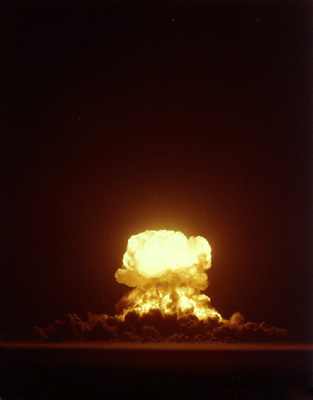Upshot-Knothole Harry facts for kids
Quick facts for kids Upshot–Knothole Harry |
|
|---|---|
 |
|
| Information | |
| Country | United States |
| Test series | Operation Upshot–Knothole |
| Test site | Nevada Test Site |
| Date | May 19, 1953 |
| Test type | Atmospheric (tower) |
| Yield | 32 kt |
| Navigation | |
| Previous test | Upshot-Knothole Encore |
| Next test | Upshot-Knothole Grable |
Upshot–Knothole Harry (also known as UK#9) was a nuclear weapon test carried out by the United States. It was part of a larger series of tests called Operation Upshot–Knothole. This test happened on May 19, 1953, at 4:05 AM. The location was Yucca Flat within the Nevada Test Site. The Los Alamos National Laboratory in the United States was in charge of this test.
Contents
The Harry Device
The device used in this test was named Hamlet. It was set off on top of a 300-foot tall tower. The explosion created a powerful blast equal to 32 kilotons of TNT.
Device Design
The Hamlet device was 56 inches wide and 66 inches long. It weighed about 4 tons. It was designed by Ted Taylor at the Los Alamos National Laboratory.
This device was special because it was a very efficient pure fission design. This means it used a process where atoms split apart to release energy. It was the most efficient design of its kind that produced less than 100 kilotons of power. The design used a new idea called a "hollow core." This "radical implosion system" aimed to use less fissionable material while still making a strong explosion.
The Detonation
The Hamlet device was exploded in Area 3 of the test site. This area is part of the larger Nevada Test Site.
Fallout and Its Effects
The Harry test released a large amount of radioactive fallout. This was the third highest amount of fallout among the 11 Upshot–Knothole tests. Fallout is radioactive material that falls to the ground after a nuclear explosion.
Fallout Spreads
Due to a mistake in calculations and a change in wind direction, a lot of fallout from this test landed in St. George, Utah. This was an unusually large amount for a test in the continental U.S. Because of this, the test became known as "Dirty Harry" in the news. It was one of the most debated U.S. nuclear weapon tests.
Government workers, including those from the United States Atomic Energy Commission, watched the fallout. They checked areas like St. George, Utah, for radioactive materials. Fallout from this test reached 3,046 counties across the United States.
Long-Term Impact
Two years after the explosion, the movie The Conqueror was filmed near St. George. The cast and crew included 220 people. Later, many of them developed serious illnesses, and some passed away. This raised concerns about the long-term effects of the fallout.
Studies showed that the Upshot–Knothole tests caused about half of the total radiation exposure for people living within 300 miles of the test site between 1951 and 1959. About 75% of that exposure came from the Harry test alone.
See also
 In Spanish: Upshot-Knothole Harry para niños
In Spanish: Upshot-Knothole Harry para niños


